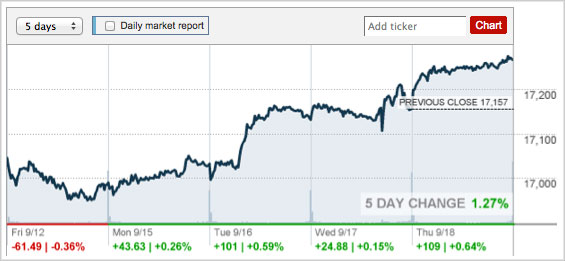
Well, Wall Street certainly appreciated news from the Federal Reserve on Wednesday that the central bank would refrain from changing its near zero-interest rate policy for a ‘considerable time.’ As the Wall Street Journal reports the Dow Jones industrial average chalked up another record close at 17,156.85. on Wednesday and 17,265.99 Thursday.
Investors like low rates because with bonds and deposit accounts paying little or nothing, money is forced into the stock market to buoy prices. Economists (some) like them because theoretically low rates make it possible for consumers to buy more stuff.
But over on Main Street, you may have heard wails of dismay at the Fed announcement as savers contemplate more years with no return on their cash hoards. I think the flip side of low interest rates and the damage they have done to non-borrowing households is under-reported and worth your look.
This Bankrate.com chart of historical CD rates (6-month, 1-year and 5-year) will induce nostalgia in many a saver; while we are 30 years out from the heady 12-percent returns of 1984, even in the past decade it was not unheard of to get 5 percent rates on cash savings. I don’t think anyone realistically expected double-digit returns on CDs, but many is the mature worker or recent retiree who predicated cash flow based on a 3-percent to 5-percent rate of return on money market accounts or certificates of deposit. That’s potentially thousands of dollars a year they are falling short of projections, for five years and with no end in sight.
Forbes calls the Fed policy a “100% tax on savers” in a pithy column and says that the hit to people with money in interest-bearing bank accounts, money-market funds and CDs has been more than $1.2 trillion in lost income since 2008, and that is not counting the erosion of purchasing power caused by inflation.
Bankrate.com highlights “6 ways federal reserve policy hurts retirees,” from poor savings returns to higher long-term care premiums and the hit to pension funds that also depended on interest income. Here’s a 24/7 Wall Street post, “How low interest rates are slamming corporate pension funds.”
I think you could go to a number of CPAs and other tax preparers, and financial advisors, for some real-life anecdotes (and leads to real savers) about how the zero-interest-rate policy has materially affected their clients. Ask the subjects if you can publish their case studies — or, if no one wants to go public, at least have the planners and accountants provide some scenarios using actual client financial numbers.
Talk with financial analysts and economists about the drag produced (at both the household and national level) when people who anticipated a certain level of interest income are forced to either forego spending or to dip into capital for expenditures like property taxes, household repairs, medical insurance and other payments they planned to cover with interest. What economy-stimulating things have these savers not done over the past five years — travel, home improvement, big-ticket purchases like furniture, appliances, cars and jewelry — and how does their restraint offset the spending supposedly stimulated among borrowers by low rates?
And ask about what readers can do if they don’t want to risk money in stocks but still need to generate some sort of income. This recent article from USA Today’s John Waggoner suggests a few options like corporate bonds and dividend-yielding stocks, though clearly there is little other recourse for the saver.
Here’s the Fed’s own non-technical explanation for the general public on why it’s keeping rates low; you may find some of the links on this page helpful.











